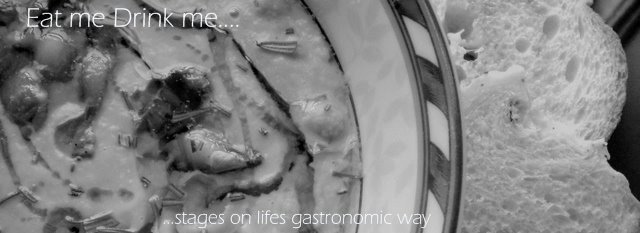I cooked up a batch of
cannelini beans in tomato sauce, a rough and rude take on
salsice fagioli. And not that crudely processed Heinz like super smooth sauced concoction those swine in Dunne and
Crescenzi have taken to foisting upon their poor clients.
Without the
salsice, its a fine thing nonetheless, and perfect for heating up cold souls on the wintry days of an Irish spring. Good for the heart. Good for the soul. And a reminder of sun in the taste of the thing. Which taste rolls off my tongue like the words that cannot entirely do the recipe justice. But hell. Such is life. Welcome to the human race, in the words of wiser, deader men than me.
But to the meat of the thing. A recipe, heavily adapted from several sources - Tessa
Kiros's Twelve (nice interview in this link),
Locatellis'
Made in Italy, and the
ever present in my cooking
Carluccio.
You will need....
A Gogol Bordello
cd. (Failing that the Breeders, and enough enthusiasm to make up the chaos. Rigoletto will fit the bill finely if neither is available.)
The gorgeous C. (for which, of course, no substitute is possible)
A rake of gorgeous C relations planning to deluge suddenly upon the house in a hungry horde of mouths. (Another, entirely unique and welcomed phenomenon)
Also
Italian spicy sausage. Taste of Italy do a fine batch of the things from
Negrini. Fine, herby, meaty fat filled little blighters.
Two tins of organic whole tomatoes, or a half a kilo of skinned tomatoes.
One can of
cannelini beans, or circa 250g of dried beans, soaked overnight.
Sage leaves, 10 (though fresh rosemary or oregano make an interesting, and perhaps more robust, alternative)
2 undeniably fresh cloves of garlic, crushed under a chefs knife.
Sea salt.
Black pepper.
Olive oil, for frying and to drizzle when serving.
Parmesan.
Bread to serve with.
To skin the tomatoes, if using fresh, boil up a saucepan of water. Cut a small cross in the skin of the base of each tomato, and drop them into the boiling water, a few at a time. After 30 or 40 seconds, plunge the tomatoes into cold water, and the skin should start to wrinkle, and be easy to just shrug off. For this dish though, good quality whole tinned tomatoes are fine. Organic seem to be particularly excellent. I used
Biona, and the strong fresh scent of tomato filled up the kitchen in seconds.
Heat some olive oil in a cast iron pan, or a large saucepan.
Pop in the garlic, and saute. Do not let it brown. Really. Add most of the sage leaves (though I tend to use oregano or rosemary), and some salt. Be careful not to burn them. Dump in the tomatoes after 30 seconds or so, and higher up the heat until the
tomatoes begin to bubble, stirring briefly, and then lower down the heat.
Leave for about 20 minutes, without stirring. Then....
In another, cast iron (no skimping here) frying pan, heat up some more olive oil, and fry off the sausage quickly, browning
lightly. I generally use four. This recipe is fine without them, as a vegetarian option. Fish out the sausages before they are cooked through. With a superbly sharp knife, cut them up into thick slices, maybe an inch apiece, and dump into the tomato sauce to finish off for about 12 to 15 minutes, at a low heat. Avoid stirring too much.
Finally, if using canned
cannelini beans, open em up, and wash them out in the tin under running water. Most
varieties only need to be reheated in boiling water - they come
precooked. Some don't, and may need cooking for longer. Check the can. In which case open them up earlier in the recipe. If using dried, cook them first, as they need about 1.5 hours. When the beans are cooked, add them to the tomato sauce mix, and cook for a further five minutes on a gentle heat. Avoid stirring, except to mix in the beans.
Taste for seasoning.
Add the remaining herbs, on top, without mixing - roughly chopped, and serve, with a small amount of grated
Parmesan. Drizzle with a little extra virgin.
Ideally the tomatoes should still retain some texture, they should still be chunky. If necessary bulk out the sauce with some reserved chopped tomato at the end.
A good
accompaniment is
ciabatta bread, rubbed with raw garlic, and toasted briefly in a gas mark 4 oven, or straight and plain. The fact
that its a third of the price of the somewhat processed crap being served up in that
unfortunately voracious city centre eatery only adds to the taste.
I'm looking for suggestions for a herby vegetarian sausage, homemade, to replace that earthy Negrini taste. Any suggestions are welcomed.



